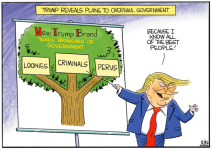signalmankenneth
Verified User
On Nov. 5, Americans hired Donald Trump to do three things: put more money into their pockets; lower prices for gas, groceries and rent and restore order at the southern border.
Trump was not hired to gut the Justice Department, abolish the FBI, pardon the Jan. 6 rioters, weaken our intelligence agencies, eliminate the Department of Education or “go wild on health.”
Trump’s initial nominations of Rep. Matt Gaetz (R-Fla.) for attorney general (now withdrawn), Pete Hesgeth for secretary of Defense, Tulsi Gabbard as director of national intelligence, Robert F. Kennedy Jr. as secretary of Health and Human Services, and Mehmet Oz as administrator of the Centers for Medicare and Medicaid Services go far beyond the directives he received from voters.
Instead of lending expertise to those departments, Trump is determined to exact revenge by gutting them. As Trump consigliere Steve Bannon says, “It ain’t morning in America.”
In 1967, social scientists Lloyd Free and Hadley Cantril explained that Americans were ideological conservatives who wanted to reduce the size of government, but programmatic liberals who did not want to cut Social Security and Medicare or eliminate education and environmental spending.
Vivek Ramaswamy, who is working with Elon Musk and his Department of Government Efficiency, says that Musk “doesn’t bring a chisel, he brings a chainsaw, and we’re going to be taking it to that bureaucracy.” Ramaswamy added, “It’s going to be a lot of fun.”
But chainsaws are not what the voters ordered. The “fun” will stop when they conclude that less government is very different from no government.
Trump is determined to overstep the instructions he received from the voters. In so doing, he is repeating a pattern that has plagued recent presidencies.
The twin examples of Bill Clinton and George W. Bush are illustrative.
In 1992, Bill Clinton was elected to improve economic conditions and lead the United States into a post-Cold War world. Campaigning as a New Democrat, Clinton rejected Franklin D. Roosevelt’s New Deal one-size-fits-all approach to big government.
But once installed in the Oval Office, Clinton put Hillary in charge of healthcare. Her expansive and complex plan was not what the voters had in mind.
Similarly, Clinton’s order allowing gays to serve in the military under the “don’t ask, don’t tell” policy also ran counter to what voters were willing to accept.
Finally, Clinton’s ban on assault weapons was viewed as an attack on the Second Amendment.
By 1994, voters wondered whether they had elected George McGovern instead of Bill Clinton. Using the slogan “God, guns and gays,” Newt Gingrich led his fellow Republicans to a resounding victory. For the first time since 1953, Republicans controlled both houses of Congress.
Assessing the outcome, Bill Clinton admitted voters sent him a message: “We just don’t like what we see when we watch Washington, and you haven’t done much about that.”
https://www.yahoo.com/news/opinion-donald-trump-won-election-160000136.html

Trump was not hired to gut the Justice Department, abolish the FBI, pardon the Jan. 6 rioters, weaken our intelligence agencies, eliminate the Department of Education or “go wild on health.”
Trump’s initial nominations of Rep. Matt Gaetz (R-Fla.) for attorney general (now withdrawn), Pete Hesgeth for secretary of Defense, Tulsi Gabbard as director of national intelligence, Robert F. Kennedy Jr. as secretary of Health and Human Services, and Mehmet Oz as administrator of the Centers for Medicare and Medicaid Services go far beyond the directives he received from voters.
Instead of lending expertise to those departments, Trump is determined to exact revenge by gutting them. As Trump consigliere Steve Bannon says, “It ain’t morning in America.”
In 1967, social scientists Lloyd Free and Hadley Cantril explained that Americans were ideological conservatives who wanted to reduce the size of government, but programmatic liberals who did not want to cut Social Security and Medicare or eliminate education and environmental spending.
Vivek Ramaswamy, who is working with Elon Musk and his Department of Government Efficiency, says that Musk “doesn’t bring a chisel, he brings a chainsaw, and we’re going to be taking it to that bureaucracy.” Ramaswamy added, “It’s going to be a lot of fun.”
But chainsaws are not what the voters ordered. The “fun” will stop when they conclude that less government is very different from no government.
Trump is determined to overstep the instructions he received from the voters. In so doing, he is repeating a pattern that has plagued recent presidencies.
The twin examples of Bill Clinton and George W. Bush are illustrative.
In 1992, Bill Clinton was elected to improve economic conditions and lead the United States into a post-Cold War world. Campaigning as a New Democrat, Clinton rejected Franklin D. Roosevelt’s New Deal one-size-fits-all approach to big government.
But once installed in the Oval Office, Clinton put Hillary in charge of healthcare. Her expansive and complex plan was not what the voters had in mind.
Similarly, Clinton’s order allowing gays to serve in the military under the “don’t ask, don’t tell” policy also ran counter to what voters were willing to accept.
Finally, Clinton’s ban on assault weapons was viewed as an attack on the Second Amendment.
By 1994, voters wondered whether they had elected George McGovern instead of Bill Clinton. Using the slogan “God, guns and gays,” Newt Gingrich led his fellow Republicans to a resounding victory. For the first time since 1953, Republicans controlled both houses of Congress.
Assessing the outcome, Bill Clinton admitted voters sent him a message: “We just don’t like what we see when we watch Washington, and you haven’t done much about that.”
https://www.yahoo.com/news/opinion-donald-trump-won-election-160000136.html


